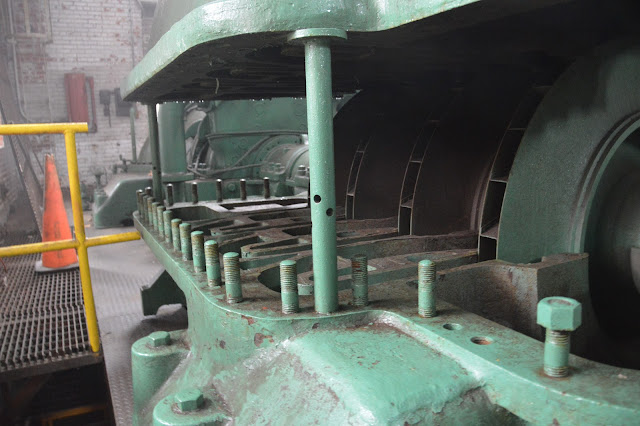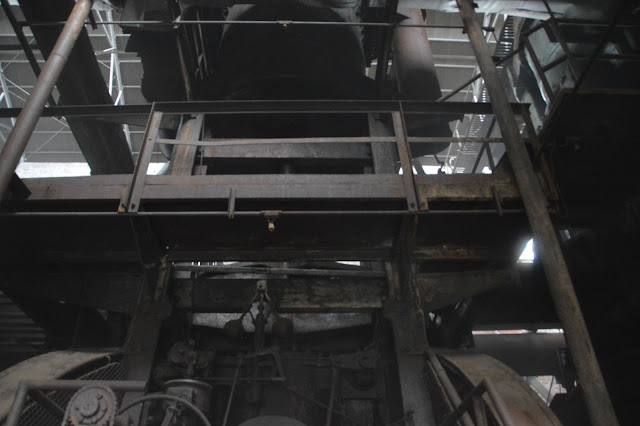A 55:38 video of the history of blowing engines
Note the size of the shaft connecting the steam turbine to the blower blades. That has got to be a lot of horsepower. Someone has restored the letters on the name plate with yellow paint.
Inside the frame is the valve linkages and other control equipment. Above you can see the ladder up to the control platform that is just below center in the view below. I wonder how this engine was oiled. If it is oiled manually, this platform would also provide access for oiling the many wear points in the linkages.
One control is so important that they use a chain so that it can be turned from ground level without having to climb the ladder to the control platform. And it can also be turned while standing on the platform.
A close up of the governor.
After I noticed the flywheel weight, I saw that the crank on the outside of the flywheel. Unlike most steam engines, this crank is not part of the drive train because I think the steam piston is directly coupled to the compressor piston. The cranks, one on each side, delivers just enough power to the flywheels to keep the engine running smoothly past the end of the strokes.
The pumps along the south side of the building was job security for the pipefitters.
And they provided some job security for the electricians as well.
Just lifting that wrench, let alone using it, would be a challenge.
If the building had lights, they were not on. The max aperture on my lens is f/3.5. I had the ISO set at 800 and the shutter speed was down to 1/6 sec. But we can see that they had a steam turbine on one side and a blower on the other side. The top of the turbine is raised so that we can see the blades.
 |
| 20200218 1174 |
A view down the other side where they had the control panels.
I cranked the ISO up to 3200 before taking these closeups of the turbine.
I include this view because the rotor has a raised-letter Ingersoll-Rand name plate.
The above blower was in the building marked by a red rectangle in the satellite image below. The yellow rectangle indicates the building holding the following blower. The blue building held the reciprocating steam blowers that had been replaced by the Ingersoll-Rand blowers.
 |
| 3D Satellite |
An overview of the blower in the tall "yellow building."
Here we can see the impellers of the centrifugal blower.
Before I include some photos of the older reciprocating blowers, I quote from item 7 of the self-guiding tour pamphlet.
BLOWING ENGINE BUILDINGIn the first two rooms [red and yellow] of the Blowing Engine Building are two Ingersoll-Rand Turbo-Blowers. These were brought to Sloss in 1949 and 1951. They are centrifugal compressors driven by steam turbines. These compact, efficient Turbo-Blowers did the work of all eight of the original Blowing Engines located directly behind the back Turbo-Blower. The Turbo-Blowers created very hot temperatures in the building, sometimes as hot as 120F in the summer months.Continue past the Turbo-Blowers and down the steps into the original Blowing Engine Biulding [blue].Built in the early 1900s, this is the oldest building on site. The Blowing Engines stand over thirty feet tall and turned flywheels twenty feet in diameter at a rate of about 30 revolutions per minute. Although built in the early twentieth century, the Blowing Engines represent the pinnacle of nineteenth-century technology. Reciprocating steam engines such as these powered the Industrial Revolution. Each engine had a steam cylinder (on bottom) and an air cylinder (on top). Steam drove the piston in the steam cylinder up and down, in turn driving the piston in the air cylinder. The moving piston pulled in air, compressed it, and pushed it out. These generated a large amount of noise. The decibel level would compare to that of standing front row at a rock concert.Lining the back wall are water pumps that moved water throughout the site.
This is an overview of one of the eight original blowing engines. It consists of two flywheels, each mounted on the outside of a frame that holds up the cylinders.
<update>
If you don't visit on a rainy day, you get better colors.
 |
| Raymond Booth posted Sloss Furnaces-Birmingham: View of a steam, single reciprocating blowing engine |
</update>
Note the governor in the middle near the top.
Looking up, we can see the bottom of the steam cylinder. The air cylinder would be on top of it. Various access platforms and big pipes did not allow me to get a view of the cylinder stack.
 |
| Howard Williams posted New Blowing Engines @ Lorain Works US Steel 1901 Notice the operator in suit & tie on floor by High pressure steam cylinder. I worked there as a supervisor in the 1960’s when they last ran. The original power source was 150 psi steam, but they were converted to 250 psi in 1922 when a new boiler house was built. [There are also some comments about using gas from the blast furnaces to generate 25hz electrical power.] |
 |
| Brett Wanamaker posted A favorite spot of mine. Bethlehem Blower House James Torgeson: The Bethlehem turbo blowers are gone. [But the above still exists.] Stacy Mays: The blowers at both Duquesne and ET were steamers. Randal McVaney: Stacy Mays CO gas engine. blowers were first generation blowers, steam followed some 40 to 50 years later with over 10,000 hp . AC motors not big enough for BF wind required. Worked at both ET and Duquesne power houses. William Mullen: They had a big explosion there and it blew the windows out of the building. They were adding oxygen into the wind from the engines and they think the grease caused the explosion. Labor’s we’re working cleaning a walkway that was above the lines that exploded. They just left the area to take a break. When they came back the walkway was gone. The engine house shanty where the man who operated the engines left to take an early shower and his shanty was damaged. Thank God no one was hurt in that explosion. |
 |
| Stacy Mays commented on Brett's post This was from Duquesne. |
Bubba Dubs posted two photos with the comment: "Bethlehem Steel PA, Gas blowing engines that provided the blast to the furnaces. Ran on either blast furnace, coke oven, or natural gas. These are a few shots I didn't lose in my hard drive crash!!"
 |
| 1 |
 |
| 2 |
 |
| Antonia Ignazio Medina posted The Korting blowing engine for blast furnace at Bethlehem Steel Corporation, Lackawanna,NY plant. Bubba Dubs: Those Kortings were replaced by Bethlehem built engines after they acquired Lackawanna Steel in 1922. They had to be placed sideways because they were longer than the Kortings. |
 |
| Smithsonian Institute, p46, 1919 [Lackawanna Steel] |
 |
| Robert Rice Sr. posted via Dennis DeBruler Ensley Alabama Blast Furnace blowing engine room, circa 1940. Where the wind for the Furnaces was made. |
ForgottenBuildings posted three photos with the comment:
A look inside the old blower house of the blast furnace.These massive “soufflantes” once fed the furnace with high-pressure air, powering the entire steelmaking process. Rows of compressors, worn control panels, and a hall built like a cathedral of industry.Nothing moves here anymore, yet the scale still feels overwhelming.
D Eric Davis shared
 |
| 1 |
 |
| 2 |
 |
| 3 |
 |
| 15:53 video Visiting The Blowing Engines at Sloss Furnaces |





















No comments:
Post a Comment